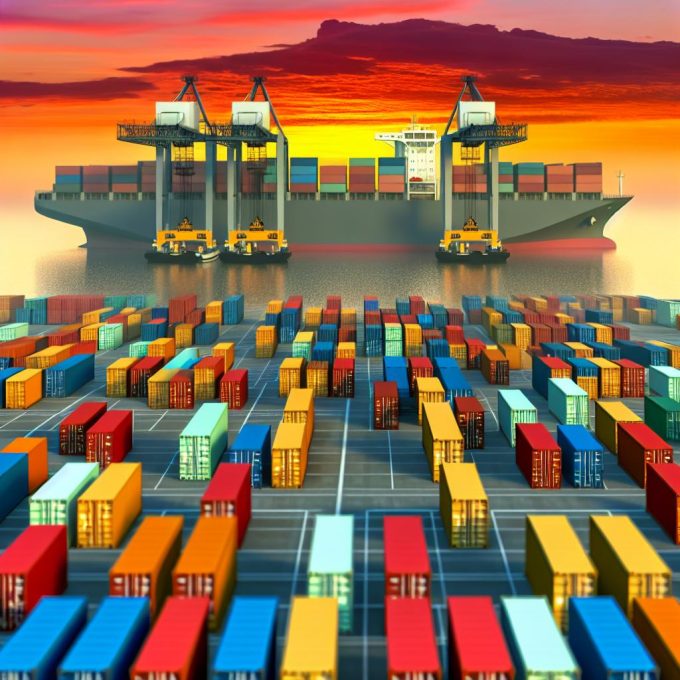Introduction to Shipping Containers
Shipping containers are pivotal components in the realm of global logistics and trade. They provide a robust, secure, and efficient method for transporting a vast array of goods across the world. These containers are designed with varying specifications to meet distinct requirements, ensuring the safe delivery of different types of cargo. Understanding the nuances of these containers is essential for optimizing logistics operations and enhancing supply chain efficiency.
Standard Dry Containers
Standard dry containers are the most prevalent type used in shipping. They are versatile and primarily intended for transporting non-perishable goods, commonly referred to as general cargo. Typically manufactured in 20-foot and 40-foot dimensions, they are constructed from durable materials such as steel or aluminum. This build ensures that they provide substantial protection against extreme weather conditions and the general rigors of handling during transit.
Dimensions and Uses
The standard dry containers’ two sizes—20-foot and 40-foot—are suitable for a wide variety of goods. The 20-foot container is often used for denser cargo, accommodating approximately 33 cubic meters, while the 40-foot version, with a capacity of around 67 cubic meters, is employed when transporting voluminous goods with a lighter density. These containers are integral to the supply chain, forming the backbone of merchandise transportation.
Refrigerated Containers
Refrigerated containers, colloquially known as reefers, are indispensable for industries demanding cold chain logistics. They cater to the transportation of temperature-sensitive goods, which include perishable foods, certain pharmaceuticals, and specific chemical products needing controlled environments.
Features of Refrigerated Containers
Equipped with a self-powered refrigeration unit, these containers can maintain a specified temperature throughout the journey. Advanced models offer additional control over the humidity and ventilation settings, allowing for fine-tuning according to the cargo’s requirements. This feature is particularly advantageous for goods that are highly sensitive to temperature fluctuations, ensuring they arrive in optimal condition.
Importance in Supply Chain
In industries like food and pharmaceuticals, maintaining an unbroken cold chain is critical. Refrigerated containers are foundational in providing this continuity, reducing spoilage, and extending the shelf-life of the products being transported. As a result, they are crucial not only for maintaining product quality but also for ensuring safety standards are met during transit.
Open-Top Containers
Open-top containers offer unique loading and unloading flexibility, addressing the challenges of handling cargo that is too large or irregularly shaped for standard container doors. They feature removable tarpaulin roofs and doors at the back end, facilitating easier access for atypical items.
Applications and Benefits
Primarily, open-top containers are utilized for transporting large machinery, heavy equipment, or other bulky items that would not fit within the confines of a traditional container. Their adaptability is driven by removable roofs that allow crane access, serving industries that deal with oversized cargo.
Flat Rack Containers
Flat rack containers are a specialized form designed for carrying oversized loads like vehicles, boats, or exceptionally heavy machinery. They feature an open-frame structure with collapsible or rigid sidewalls, enabling cargo extension beyond the usual confines of a container.
Advantages of Flat Rack Containers
The open layout of flat rack containers greatly enhances flexibility during loading and unloading phases. This type of container is specially engineered to endure weights and dimensions that are beyond the capacity of standard containers. Their robustness and flexibility make them essential for industries dealing with large, industrial items.
Usage in Industrial Sectors
Flat rack containers find widespread application in sectors such as construction, mining, and manufacturing. They enable the transportation of items that are otherwise challenging to manage, ensuring safe transit from origin to destination.
Tank Containers
Also known as ISO tanks, tank containers are expertly designed for the conveyance of liquid or gaseous substances. Featuring a core of stainless steel and often lined with insulation, these containers guarantee the secure and efficient transport of chemicals, food-grade liquids, and hazardous materials.
Key Considerations for Tank Containers
When utilizing tank containers, important factors to consider include the container’s pressure and temperature resistance, as well as the safety certifications and regulatory compliances necessary for transporting certain materials. These considerations are crucial for ensuring the safe handling and transportation of potentially hazardous or sensitive substances.
Industry Significance
ISO tanks are a crucial element in the transportation of volatile chemicals and sensitive liquids. The ability to move such substances safely and efficiently supports a range of industries, from food and beverage to chemical manufacturing, ensuring supply chains remain robust and uninterrupted.
Conclusion
An in-depth understanding of the various types of shipping containers is fundamental to anyone engaged in international trade and logistics. Each container type is tailored to meet specific demands, facilitating the efficient and safe transport of goods across the globe. The choice of the appropriate container can significantly impact logistics operations, enhancing both their efficacy and reliability. For more information on the diverse array of shipping containers and their respective applications, further exploration or professional consultation is recommended. Ensuring the right container selection aligns with logistical goals is imperative for maintaining and advancing supply chain efficacy.

